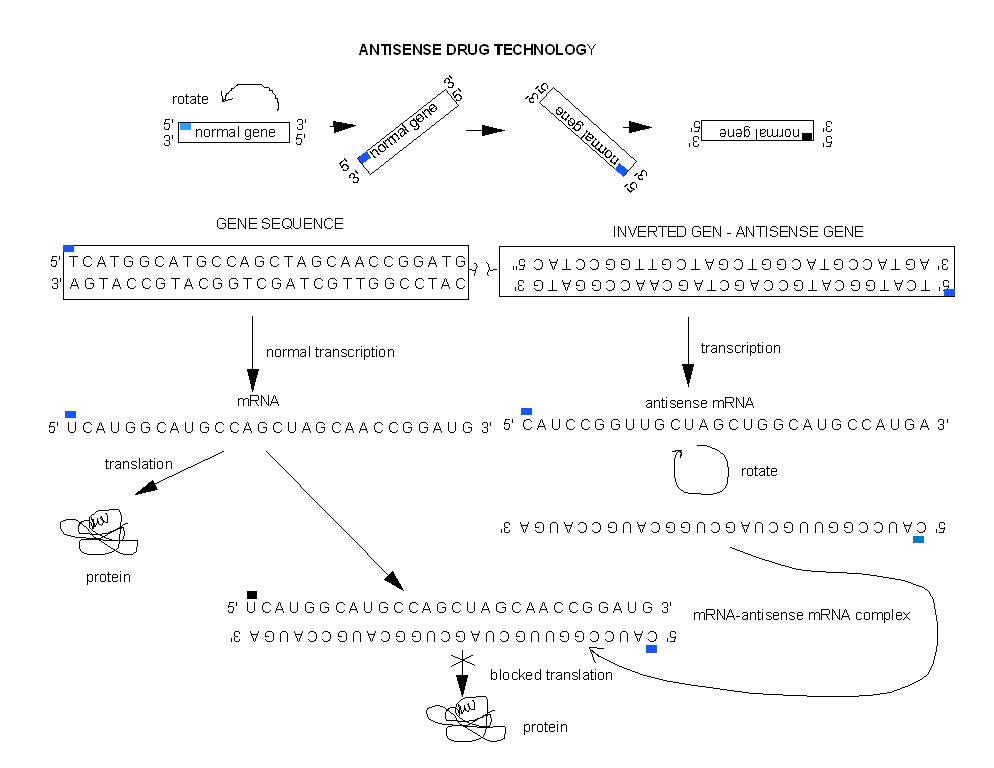Biochemistry Online: An Approach Based on Chemical Logic

CHAPTER 5 - BINDING
E: MODERN METHODS IN DRUG DEVELOPMENT
BIOCHEMISTRY - DR. JAKUBOWSKI
Last Updated: 03/31/16
|
Learning Goals/Objectives for Chapter 5E: After class and this reading, students will be able to
|
E7. RNA Binding Drugs
One of the best new alternatives is to design a RNA molecule complementary to a given mRNA for a specific protein selected for inhibition. This antisense RNA forms a dsRNA when it binds to the mRNA and inhibits translation of the mRNA.
Figure: antisense RNA forms a dsRNA
Cells can be altered through genetic engineering to make an antisense RNA within the cells by inserting an inverted copy of the target cDNA for the gene of interest into the cell, and allowing the cell to manufacture its own drug!
Figure: Cells can be altered through genetic engineering to make an antisense RNA within the cells

Even more exciting is the use of RNAis (RNA inference) for disease therapy. In contrast to traditional drugs, RNAis are one of nature's proven methods to inhibit gene transcription or RNA translation (mainly from viruses). Even though it was only discovered five years ago, it may be only a few years before drug trials based on RNAi take place. Especially promising are trials for siRNAs that inhibit HIV. To show that it works in organisms, mice were infected with a fusion of hepatitis C gene segment and a gene for a fluorescent protein luciferase. Specific siRNAs-treated mice showed a dramatic decrease of fluorescence, but not those treated with a nonspecific RNAi. As with other drugs, getting them into target cells is proving difficult. Simple liposome-encapsulated siRNAs apparently are not as effective as hoped. Carrying the siRNA into the cells with virus is yet another idea. Some companies pursuing this technology are shown below.
-
 Antisense
drugs: AVI BioPharma
Antisense
drugs: AVI BioPharma
-
 Calando:
RONDEL (RNAi/Oligonucleotide Nanoparticle Delivery) in which siRNA
is bound to a block polymer of a positive polymer interspersed among
cyclodexdrins, protecting the. siRNA from degrations by nucleases.
These self-associate to form nanopartaicles. Adamantine (hydophobic)
linked to polyethylene glycol (polar) to which targeting proteins (like
transferrin) are attached are added to the nanoparticles, leading to
PEG-dependent stabilization of the nanoparticle (and si-RNA) and
transferrin-dependent delivery to target cancer cells, which over
express transferrin receptors.
Calando:
RONDEL (RNAi/Oligonucleotide Nanoparticle Delivery) in which siRNA
is bound to a block polymer of a positive polymer interspersed among
cyclodexdrins, protecting the. siRNA from degrations by nucleases.
These self-associate to form nanopartaicles. Adamantine (hydophobic)
linked to polyethylene glycol (polar) to which targeting proteins (like
transferrin) are attached are added to the nanoparticles, leading to
PEG-dependent stabilization of the nanoparticle (and si-RNA) and
transferrin-dependent delivery to target cancer cells, which over
express transferrin receptors.
Navigation
Return to 5E. Modern Methods in Drug Development Sections
Return to Biochemistry Online Table of Contents
Archived version of full Chapter 5E: Modern Methods in Drug Development

Biochemistry Online by Henry Jakubowski is licensed under a Creative Commons Attribution-NonCommercial 4.0 International License.